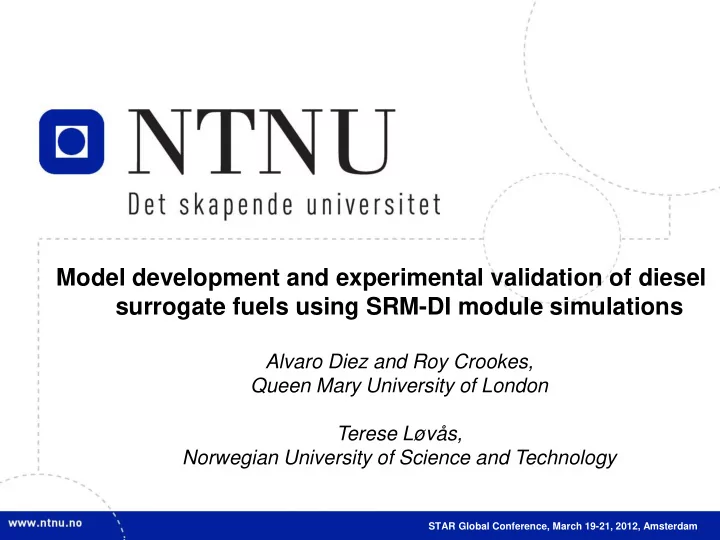

1 Model development and experimental validation of diesel surrogate fuels using SRM-DI module simulations Alvaro Diez and Roy Crookes, Queen Mary University of London Terese Løvås, Norwegian University of Science and Technology STAR Global Conference, March 19-21, 2012, Amsterdam
2 Outline • Objectives • Auto-ignition characteristics • Experimental and numerical model • Model validation • Future work
3 Objectives • Surrogate fuels are increasingly important to cut cost in engine research • Surrogate fuels have known physical/chemical properties and combustion characteristics similar to conventional fuels • Surrogate fuels are simpler in terms of composition (mainly one or two component fuels)
4 Objectives • New surrogate fuel models needed to mimic “new fuels”, such as bio-fuels where lack of kinetic data is limiting • Even typical surrogate fuel components (n-heptane, dodecane, hexadecane, toluene etc) have complex kinetics • Combustion characteristics become accordingly sensitive to blending due to different fuel-air mixing • Crucial with modeling tools that enable detailed description of the kinetics and the engine conditions
5 Auto-ignition characteristics • Fuel-air mixing properties affects ignition • Injection profile affects ignition • Combustion phasing affects efficiency • Definition of ignition time affects ignition • The model should capture these effects
6 Experimental validation rig • Optical chamber provides a compression-ignition zone optically accessible • Fitted with a piezoelectric pressure transducer for cylinder pressure and energy conversion rate analysis • Fitted with a high pressure common rail injection system with injection pressures up to 160 Mpa • LabVIEW custom built program as ECU • An independent intake manifold with an intake heating up to 600 K
7 Experimental validation rig
8 • Injector characteristics Siemens Lynx Injector Injection Pressure 80 MPa Number of Holes 7 Cone Angle 152° Hole Diameter 110 µm Type microsac • Phantom V 4.3 high speed colour CMOS • The recording speed for this study 6000 fps →1 crank angle per frame • The image resolution was 256 x 256 pixels
9 Optical experiments: Diesel: Dodecane:
10 DI SRM model in DARS • Stochastic distribution of properties in the domain → important for direct injection systems • Accounts for free mixing of particles and heat transfer to the walls • Accounts for detailed chemistry • Accounts for detailed engine specifications • Injection determined by user defined injection profiles → obtained directly from the experiments
11 Reaction kinetic challenge • Surrogate fuel model: – Detailed mechanism for n-alkanes (C8-C16) – E.g. Westbrook et al. mechanism: contains oxidation paths for both n-dodecane and n-hexadecane https://www-pls.llnl.gov/?url=science_and_technology- chemistry-combustion
12 Westbrook et al.:
13 Reduced Westbrook et al.:
14 Side chamber specifics
15 Definition of ignition delay Experimental: luminosity vs pressure traces 6 Diesel Dodecane 5 Hexadecane motoring Cylinder Pressure / MPa 4 3 2 1 injection 0 -40 -35 -30 -25 -20 -15 -10 -5 0 5 10 15 20 25 30 35 40 Crank Angle / degree ATDC
16 Definition of ignition delay Numerical: OH initiation vs OH rise
17 Results
18 Results Ignition delay in optical chamber for diesel and n-dodecane 4 Diesel (cylinder pressure) Diesel (luminosity) 3.5 Dodecane (luminosity) 3 Dodecane SRM (OH initiation) Ignition delay / ms Dodecane SRM (OH rise) 2.5 2 1.5 1 0.5 0 700 750 800 850 900 950 Temperature / K
19 Results Ignition delay in optical chamber for diesel and hexadecane 4 Diesel (cylinder pressure) 3.5 Diesel (luminosity) Hexadecane (cylinder pressure) 3 Hexadecane (luminosity) Ignition delay / ms 2.5 Hexadecane SRM (OH initiation) 2 1.5 1 0.5 0 700 750 800 850 900 950 Temperature / K
20 Future work • Combine more fuel blends • Investigate for different injection characteristics • Investigate for bio-fuels (BioEng project)
21 Acknowledgement • EPSRC, funding of project “ Design and assessment of suitable surrogate fuels for diesel fuel modelling” • Nordic Councils’ Top Research Initiative, funding of project “BioEng”
Recommend
More recommend